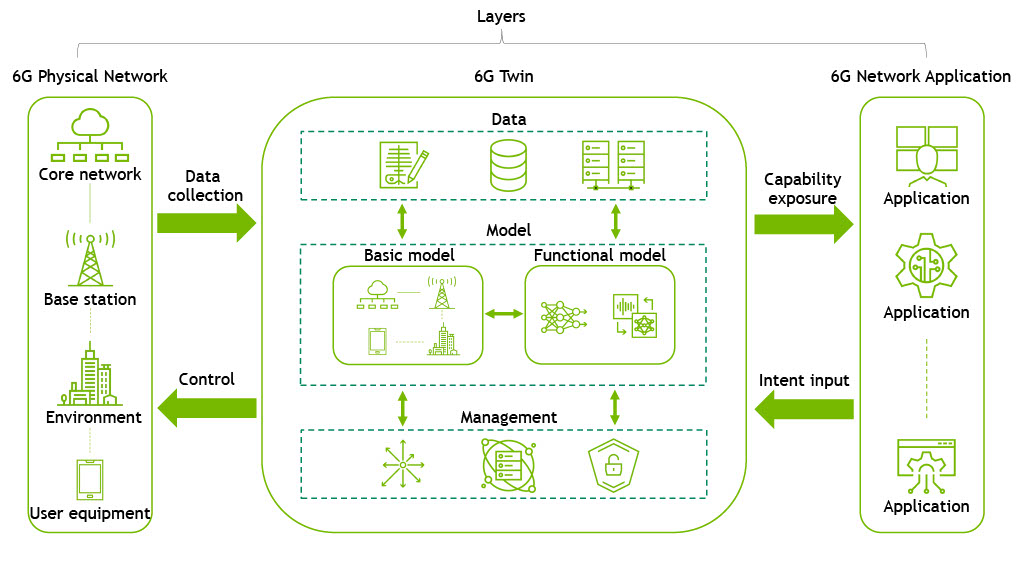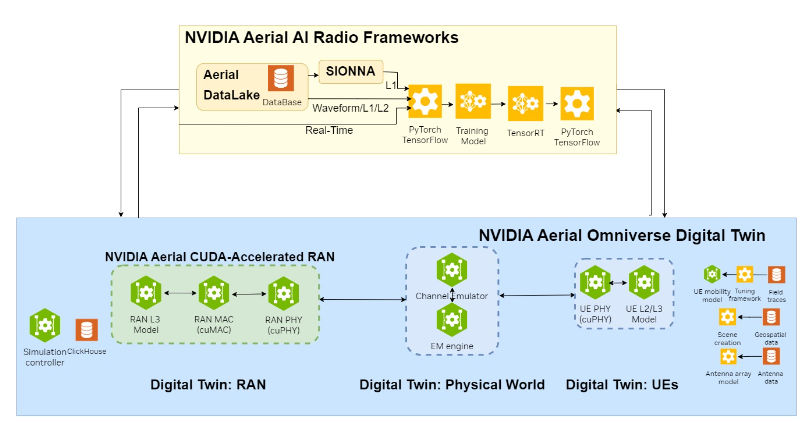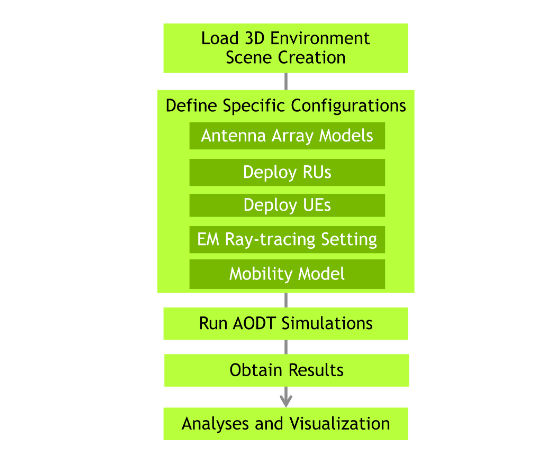The journey to 6G has begun, offering opportunities to deliver a network infrastructure that is performant, efficient, resilient, and adaptable. 6G networks will be significantly more complex than their predecessors and will rely on a variety of new technologies, especially AI and machine learning (ML).
To advance these new technologies and optimize network performance and efficiency, there is the need for a wireless network digital twin platform for research and development. The network digital twin relies on a digital replica of the mobile network in a realistic physical radio environment, as illustrated in Figure 1.

The NVIDIA Aerial Omniverse Digital Twin (AODT) provides a network digital twin platform to accelerate 6G research and development. AODT leverages key NVIDIA technologies—including the near real-time ray tracing capabilities of NVIDIA RTX GPUs and NVIDIA Omniverse—to realize a physically accurate, highly performant, and modular digital twin platform for wireless network.
From link-level simulations to system-level simulations
Research and simulation of radio access network (RAN) can generally be subdivided into two major areas:
- Link-level simulations are essential for analyzing the performance and characteristics of point-to-point communication. NVIDIA Sionna has emerged as a powerful tool in this domain, offering a GPU-accelerated open-source library specifically designed for link-level simulations. This innovative platform enables researchers and engineers to rapidly prototype complex communication algorithms, significantly accelerating the development process.
- System-level simulations study performance and characteristics when several point-to-point links are simultaneously transmitting and receiving, and how they affect each other. NVIDIA AODT brings system-level simulation capabilities to the RAN research and development community, thus enabling the analysis and development of concepts—spanning across layers or involving multiple transmission points, for example.
NVIDIA AODT enables physically accurate simulations of complete 6G systems, from a single base station to a comprehensive network with a large number of base stations covering an entire city. It incorporates software-defined RAN and user-equipment simulators, along with realistic terrain and properties of the physical world. Using the AODT enables researchers to simulate and build base-station algorithms based on site-specific data and to train models in real time to improve transmission efficiency.
This post provides an overview of the features and benefits of the NVIDIA Aerial Omniverse Digital Twin (AODT), as well as a typical workflow for using it.
Transforming wireless research and development
NVIDIA AODT offers researchers an open modular platform, the ability to test before deployment, an advanced physically accurate electromagnetic (EM) solver, and much more.
Open and customizable modular platform
The AODT is built on NVIDIA Omniverse, which enables the use of custom extensions, a convenient graphical user interface, beautiful visualizations, and remote collaboration for distributed teams. Developers can easily replace AODT modular blocks with ecosystem partners’ solutions using open APIs. Those APIs are well defined and documented in the AODT user guide.
In addition, customers can replace any module with their own customized model, and replace AODT text-book reference design with innovative layer-1 (L1) or Layer-2 (L2) algorithms in a realistic system-level simulation environment.
3GPP-compliant platform for 6G standardization
AODT provides a physically accurate radio environment, user equipment (UE) mobility, and standard-compliant waveforms plus signaling to assess the benefits of new AI use cases such as beamforming, channel state information (CSI) compression, and positioning.
Testing before deployment
The AODT is tightly coupled with the NVIDIA Aerial CUDA-Accelerated RAN, enabling researchers and developers to test the system-level performance and efficiency of their GPU-accelerated algorithms before deploying them in a live network. You can test algorithms such as multiple input multiple output (MIMO) detection, scheduling, and more.
AI and ML in the loop with digital twins
As explained in AI – What Does It Mean for the RAN Market?, AI and various ML algorithms will be important research areas for the evolution of 5G and the development of 6G. When AI and ML are part of the future network specifications, NVIDIA AODT can be used to train new algorithms for specific environments. The AODT consists of a digital twin of a RAN, wireless physical world, and user equipment (UE). The AODT is fully connected with NVIDIA Aerial AI Radio Frameworks to leverage various neural network models and NVIDIA TensorRT, and make the AI/ML system-in-loop, as illustrated in Figure 2.

The platform provides researchers with prebuilt tools to run complex simulations faster and explore AI RAN in new ways to improve the performance and efficiency of future wireless networks.
Advanced physically accurate electromagnetic solver
Radio propagation is the behavior of radio waves as they travel from one point to another. To accurately model radio propagation, the embedded electromagnetic (EM) solver is a state-of-the-art software component based on ray tracing that includes all the different characteristics of physical radio propagation. The EM solver is implemented in CUDA code, making it blazingly fast compared to contemporary solutions.
The AODT EM solver has a comprehensive ray tracing model, taking into account reflection, diffraction and directional diffuse scattering effects. The antenna patterns can also be defined at each antenna element level. The GPU-accelerated software makes the EM solver more than 100x faster than traditional CPU-based channel simulators, based on early benchmarking tests.
Partner enhancements
Thanks to its modular design, each modular block in NVIDIA AODT shown in Figure 2 is replaceable by a partner’s product. It’s also an API-driven open platform. Partners can adopt the EM solver with their own traditional propagation model for a comprehensive suite of wireless channel simulators. It can also integrate with commercially available antenna models for partners to take advantage of system-level simulation with AI/ML agents. For example, Ansys has showcased this modularity with the integration of Perceive EM software and NVIDIA AODT using the EM Solver API. To learn more, see Pioneering the Future of Radar Systems and Wireless Communications Optimization With Synthetic Data on Demand.
The Aerial CUDA-Accelerated RAN can work with various 3GPP- and O-RAN-compliant O-DUs, enabling researchers to develop various innovative transceivers. 6G researchers and partners can also take advantage of open interfaces with CUDA-accelerated MAC layer (cuMAC) to generate synthetic data, creating various schedulers and radio resource control to improve network and user performance.
The AODT platform can be run on-premises or on the cloud (with Azure, for example). For on-premises, the AODT can be installed and run on the users’ own servers and network, giving users full control and ownership of their data and applications. The cloud gives users the convenience and flexibility of accessing the platform from anywhere at any time.
Site-specific, city-scale, near real-time system-level simulations
NVIDIA AODT is scalable from the smallest to the largest of environments. It supports everything from the smallest deployments of a single base station with a few users running on a single GPU to large city-scale models with hundreds of base stations and thousands of users running on large GPU clusters. The GPU-based solution takes milliseconds to calculate city-scale radio frequency (RF) environments. Various benchmark tests have demonstrated that EM solver and RAN simulations are magnitudes faster than traditional CPU-based simulations. Further optimization will improve the near real-time simulation experience, moving toward real time.
The AODT can support the geographic information system (GIS), from level of detail (LOD) 1 and LOD 2 (city maps) to LOD 3 and LOD 4 (architectural details such as roof overhangs, openings, and other façade details; indoor features like rooms and furniture). This produces city-scale simulations with much finer granularities. Additional enhancements to the UI make the platform more accessible and user friendly.
Functionally full-stack RAN layers
NVIDIA Aerial CUDA-Accelerated RAN, a major component of AODT, consists of 3GPP-compliant software-defined physical (PHY) and medium access control (MAC) layers, both in uplink and downlink. This serves as a reference design for researchers and developers in their work to find new innovative solutions for the RAN. This has strong ecosystem value, as there won’t be any need to invest in separate resources for this implementation work. And as new features are added to the NVIDIA Aerial CUDA-Accelerated RAN, they will also be available in NVIDIA AODT.
For example, the embedded CUDA-accelerated physical layer (cuPHY) in AODT enables researchers to study various beamforming and neural receivers in a multiple cell and site-specific environment. In addition, having cuMAC embedded enables the development of AI/ML-based Layer 2 and above innovations. For example, this can help drive the development of custom radio resource management methods to improve spectral efficiency and ensure quality of service.
Workflow for a simulation using NVIDIA AODT
This section presents a description of a typical workflow. Figure 3 shows how to run a simulation leveraging NVIDIA AODT. Examples and post-scripts are also provided in the AODT User Guide.
- Load the 3D environment (GIS data). AODT supports both CityGML and CityJSON data formats.
- Define specific parameters for embedded models, including:
- Electromagnetic elements, which provide key parameters for radio units and terminals plus antenna models (types of polarization, output power, and so on).
- Mobility model to specify parameters for different mobility classes (pedestrians, cars, trains, and so on).
- Run the simulation
- Obtain the results, such as:
- Channel impulse response (per antenna)
- Downlink and uplink throughput
- Visualize the results leveraging the graphical capabilities of NVIDIA Omniverse (optional).

Summary
NVIDIA AODT is a powerful and versatile platform that provides a large-scale, physically accurate model of radio wave propagation for system-level RAN simulations. The platform is tightly integrated with PyTorch and TensorRT, enabling AI/ML in the loop. GPU-accelerated physics-based modeling, a user-friendly interface, and the incorporation of functionally exact RAN layers makes AODT ready for 6G. It is an ideal platform for researchers, algorithm developers, network engineers, and other professionals who need to simulate and analyze wireless networks in a variety of environments.
Ready to get started? You can access the NVIDIA Aerial Omniverse Digital Twin by joining the NVIDIA 6G Developer Program.